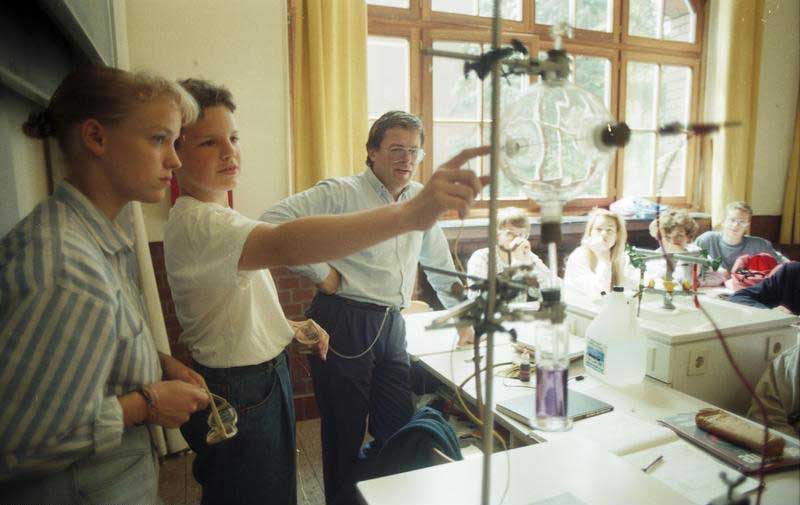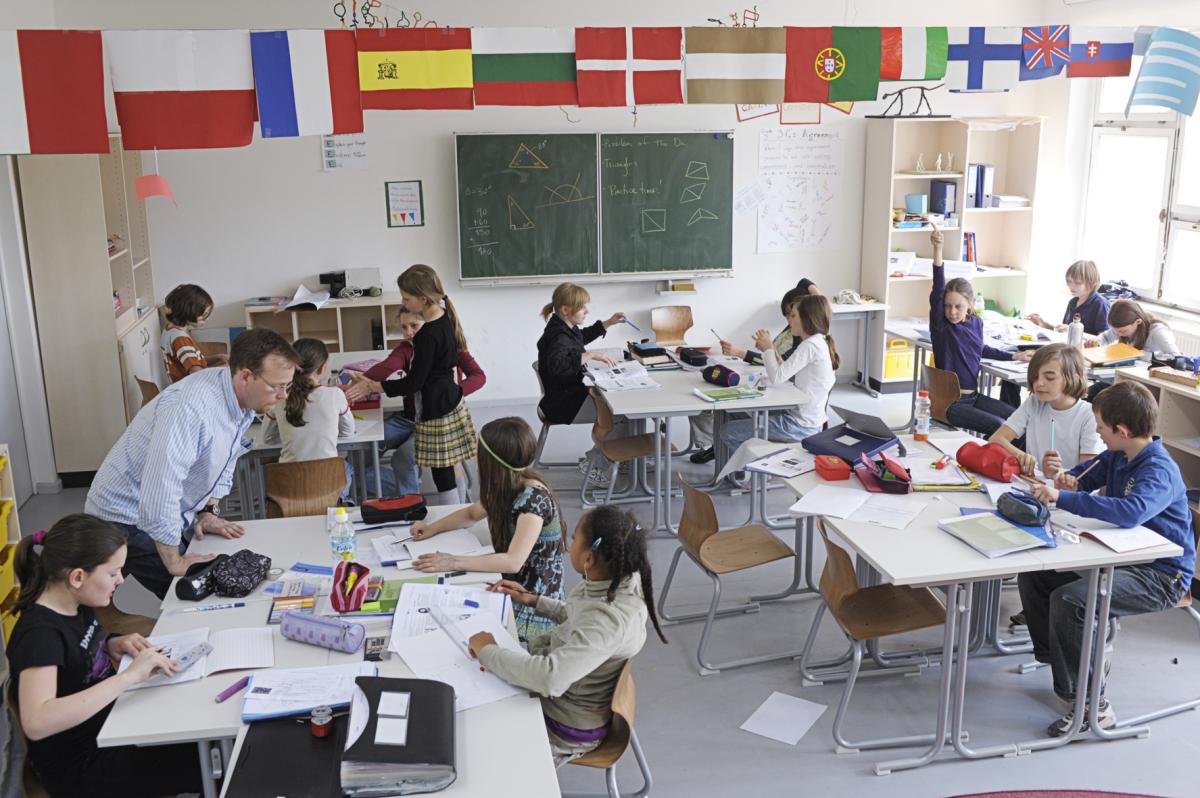Climbing the PISA ladder Inspire article
Since the first PISA study in 2000, changes in the system and innovations in the classroom have improved performance in Germany.
Since it was first introduced, the triennial OECD Programme for International Student Assessment (PISA) has been the subject of concern or celebration for teachers and policy makers. However, in more than a decade since its launch, it has also led to innovations and changes in teaching practice. The PISA reports reveal how practices have changed and what can be learned.
A focus on Germany

the years
Image courtesy of the German
Federal Archive/Wikimedia
Commons
It was a shock to the population of Germany when, in December 2001, the results from the first 2000 PISA study were published. The results showed much lower maths and science performance than the average for OECD countries. Children of poor socio-economic families were primarily at risk, and so a very unequal school system was revealed.
The debate rising from the PISA results kickstarted different reforms in the educational system, by placing emphasis on individual support, extending the school day and introducing federal educational standards.
By 2012, Germany had improved reading, maths and science scores to above the OECD average – mainly because of improvements in low-achieving students – and was the only European country to show improvement in both mathematics ability and equalityw1.
Wolfgang Pöschl, a science teacher in a Gymnasium in the state of Bavaria, explains that he has noticed how the reform has put much more emphasis on social mobility. In his area, a lot of parents do not send their children to the Gymnasium even if they have good grades, because they think that Realschule is sufficient to get a good job or to study at a university of applied science (see box for an explanation of the German school system).
At Wolfgang’s school, the staff encourage families to let their children stay in the Gymnasium if they have the talent. To help with this, the way that children are assessed has changed to make it easier to identify talented students and to argue that they should continue their education.
“We used to test a lot of pure knowledge,” Wolfgang explains. “The problem is that students from wealthier families usually have better general knowledge and therefore get better grades. Now we try to teach and test skills in science. So you can get good grades even if your parents don’t teach you a lot of general knowledge at home.”
Individual support
One of the newest initiatives in Bavaria is the so-called individual learning class, where the teacher’s role is to coach individual students to deepen their understanding of a topic or to provide extra support in those areas in which the student has difficulties.

School/Wikimedia Commons
This kind of mentoring is quite new, so there is yet no data to prove if the project is a success or not, Wolfgang says.
What is a success though, according to the experienced science teacher, is another initiative: intensification classes. In these extra classes on basic subjects, no new material is introduced but the students practise existing skills.
“It’s helpful because I can give different exercises to different students and help them solve them. A lot of people think that these classes are really successful in helping low-achievers,” Wolfgang explains.
He thinks that this initiative is a success and that it helps the slow-learning students to understand faster and better.
The benefits of innovation
The introduction of ‘remedial education’ is a trend that was picked up by the OECD in its July report Measuring Innovation in Education: A New Perspective (OECD, 2014), which looked at the association between school innovation and educational outcomes. The report concluded that high maths performance, more equal learning and more satisfied teachers correlate with the amount of educational innovation in each country.
The report also noted the move towards context-based learning and the importance of skills over pure factual recall in Europe, including introducing more student-directed experiments. In addition, it recognised the benefit of ‘enrichment’ activities, for example in the UK and Slovenia.
Wolfgang Pöschl’s Gymnasium offers extra courses, usually in the afternoon, in which students can specialise in alternative skills such as music, programming and foreign languages. However, these ‘Leistungskurse’ or extension courses have been stopped in the past two years to make time for the individual and intensification classes.
Longer school days
Many German states have chosen to extend school hours to move closer to the OECD averages of 842 hours for primary schools and 936 hours for secondary schools.
Longer days give teachers more time to focus on inclusion. But even though more time has the advantage of more hours to spend with individual students, it also has its limitations, Wolfgang explains, as students have less time at home to complete their homework.
As a consequence, teachers usually don’t give written homework for the next day if the student has afternoon classes. Depending on the grade, students have afternoon classes up to four times a week.
Those who have many afternoon classes do get tired by the end of the day, so complicated topics must be taught earlier in the day. The planning of curricula becomes a challenge for many teachers.
Between 2003 and 2009, Germany spent €4 billion on the establishment of full-day schools. It is still voluntary if a school wants to make afternoon classes obligatory.
Happy but noisier
It is clear that by innovating in the classroom, Germany has improved its overall academic performance. Not only have testing scores improved, but also the motivation and enjoyment of attending school has been enhanced. According to the 2012 PISA, German children have the highest self-belief in maths, showing motivation and believing in their own ability to learn.
The only little fly in the ointment is that the same children that report enjoyment of learning also report more noise and disorder in the classroom.
The German three-pillar school system
After four or six years of primary school, depending on which state they live in, German school students are divided into three different pathways:
- The Gymnasium offers a demanding academic programme for those who will be allowed to apply for university.
- The Realschule, with a less demanding academic programme, leads to a lower secondary diploma.
- The Hauptschule offers a programme for those of limited academic ability or interests and culminates in a school-leaving certificate.
The system has come under criticism from PISA for essentially dividing students according to social background.
References
- OECD (2014) Measuring Innovation in Education: A New Perspective. Paris, France: OECD Publishing. ISBN: 9789264215696
Web References
- w1 – Read the full 2012 PISA results and various overview documents.
Review
By discussing the evolution of PISA results, the author emphasises the image of school as the pivotal means to counter the impact of socio-economic differences on youth job opportunities and life horizons.
The article raises the importance of studying the entire organisation of education as the major determinant of learning success in mathematics and sciences. Of course, evaluation of teachers or the investment in material and technological resources are also important. But the innovation and creativity delivered to the class planning process –to achieve a more goal- and context-oriented learning – play a role whose importance is difficult to surpass.
I hope this text stimulate a larger debate around the following questions among school decision-makers and teachers:
- What themes and classroom methodologies have the potential to improve students’ attitudes towards maths and science learning?
- How should schools be organised to support all kinds of students and thus promote social mobility?
- Are good practices shared and reproduced? How can this be achieved?
And, perhaps, more relevant: - What is the best approach to treating PISA results? Is the assessment itself an end or simply an additional criterion with which to work out the prevailing trends?
Luis M. Aires, Antonia Gedeao Secondary School, Portugal





